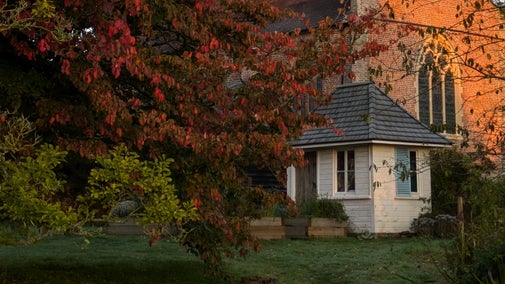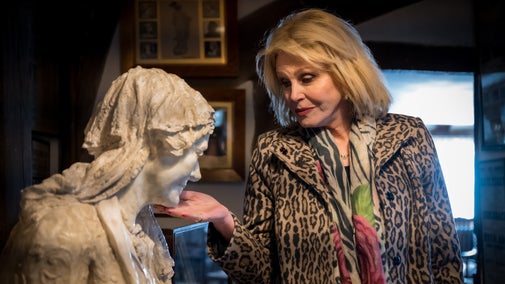
Discover more at Smallhythe Place
Find out when Smallhythe Place is open, how to get here, the things to see and do and more.

Smallhythe Place has a long and varied history. It has been one of the most significant shipyards in medieval England, a simple working farm, and later the home of distinguished Victorian actress, Dame Ellen Terry.
The precise age of Smallhythe Place is not known, although the style of the building suggests that it was built in the early 16th century.
After the decline of the shipyard at Small Hythe, the house became associated with farming. The Barn was builtin the late 17th century and may have replaced a smaller, earlier building. Find out more about the shipbuilding at Smallhythe here.
Traditionally, the house was believed to have been the port reeve's (local official's) house, but there is no documented evidence for the existence of a port reeve at Small Hythe. It is also possible that the house may have served as an inn or courthouse or may have been the home or office of a local shipbuilder. The River Rother once flowed through Small Hythe, allowing a major medieval shipyard to thrive; both Henry V and Henry VIII had large ships built here.
At the height of its success, Smallhythe was a community of around 200 people, most of whom were involved in shipbuilding. What is now farmland was once the great River Rother, a river that provided an important link between Tenterden and Rye, and had several royal commissions built there.

Victorian actress Dame Ellen Terry led an extraordinary and unconventional life. She was the leading figure of Shakespearean drama, giving unrivalled performances of his iconic female leads throughout a career spanning 65 years.
Ellen instantly fell in love with Smallhythe Place when she was riding through from Rye to Tenterden with fellow actor Henry Irving on her pony and trap. She asked to be told if it were ever to become available to buy. Some years later in 1899 a postcard with a Tenterden postmark was sent to Ellen's Chelsea house with the brief message ‘House for Sale’. Later that year she purchased Smallhythe Place and lived there happily for almost 30 years.
Throughout her time at the house Ellen was surrounded by family and friends, some of whom, like Ellen, were esteemed thespians of the era. Her daughter, Edy Craig, was a prolific theatre director, producer and costumier, and lived next door in the Priest House. Henry Irving, Ellen's close friend and colleague, also visited several times throughout their partnership at the Lyceum Theatre in London.
For Ellen, Smallhythe Place was also a retreat away from her busy acting career in London. She took great joy in escaping to the countryside and tending to her much-loved ‘daffodilly farm’ where she found peace and solace in contrast to city life.
Immediately after Ellen's death in 1928 Edy transformed the house into a memorial museum to commemorate her mother's remarkable life and career. She left Ellen's bedroom very much as it had been, but used the sitting room and the dining room for historical displays. She also converted the late 17th-century thatched barn in the garden into a theatre, which still holds performances to this day. Read more on Edy Craig here.

The barn was transformed into a theatre in 1929 by Ellen Terry’s daughter, Edith Craig, as a way to keep her mother’s legacy alive. Throughout Ellen Terry’s residency at Smallhythe Place her daughter, Edith, had wanted to turn the barn into a proper theatre and use it to stage public performances, but Ellen refused – she wanted to preserve the property as a refuge from acting. Nevertheless, in 1928 Edith decided to proceed with her plan, with a view to holding a Shakespearean matinee on the anniversary of Ellen's death the following year.
To make this happen, Edith established the Ellen Terry Fund and Memorial Matinees in 1929 and arranged a benefit at the Palace Theatre in London which raised enough money to get the barn ready despite holes in the roof and gaps in the timbered walls.
Edith also raised funds for the theatre in other ways, including ‘selling’ 100 chairs, with rush seats, for £1 each. The chairs cost only 5 shillings (25p) each, so Edith was able to put 15 shillings (75p) from each sale towards financing the theatre. The ‘purchasers’ had their name engraved in pokerwork on the front of the chair back. More recently, the barn theatre was fortunate to receive funding from the Rye & District National Trust Association to refurbish these chairs.
As Edith had intended, the Barn Theatre was opened to the public on 21 July 1929, a year after Ellen Terry's death, by which time a 19th-century shelter shed to the side of the theatre had been refurbished for use as dressing rooms. Edith chose the play, made the costumes, oversaw the set designs and rehearsed the cast. The tradition of an annual commemorative performance continues to be kept alive by the wonderful Summer Theatre Company and their rendition of a different Shakespeare classic every July and August.
Edith passed away in March 1947 when planning that year's Shakespearean matinee, and actors Sir Lewis Casson and Sir John Gielgud established the Ellen Terry Fellowship that presented the annual memorial matinees from 1947 to 1961.
In 1997, which marked 150 years after Ellen’s birth, a theatrical Angels Appeal was launched to raise funds. Angels who donated £100 were given a certificate, and Guardian Angels who donated £1,000 had their names put on the back of the original rush-seated chairs.
There were 22 Guardian Angels, including Sir Paul and Linda McCartney, and Sir Cameron Macintosh. In 2004 the National Trust took over the management of the theatre and introduced a season-long programme of productions to supplement those of the Barn Theatre Society, which was established by Edith in 1932.

Two uncatalogued folders of paintings by the prolific artist, Pamela Colman Smith, were found by house steward Susannah Mayor at Smallhythe Place in 2013. Find more about her artwork on display here.
Pamela was born in London in 1878, and had many creative collaborations with English actors, writers, and artists. This included Irish poet W.B. Yeats who commissioned her illustrations for his 1898 Book of Illustrated Verses, and she designed what is still the world’s most popular Tarot deck: the Waite-Smith deck.
In 1899, Pamela joined the Lyceum Theatre in London as a set designer and was taken under the wing of both Ellen and Henry Irving. Pamela also formed a firm friendship with the theatre’s business manager Bram Stoker and illustrated his final book: The Lair of the White Worm.

Find out when Smallhythe Place is open, how to get here, the things to see and do and more.
Discover what's on offer for families throughout our open season.

Step into the Ellen Terry Museum at Smallhythe Place, a creative haven dedicated to the late Victorian actress, curated by her daughter Edy Craig.

Discover this charming cottage garden surrounding the house, with borders packed full of flowers, an orchard underplanted with bulbs and roses tumbling over the front of the house.

Joanna Lumley follows in some famous footsteps as patron of the Barn Theatre. Discover how her local connections, love of the stage and acting pedigree make her the perfect choice.

Find out about the work we do in the winter months to maintain and conserve the museum, house, theatre and garden at Smallhythe, ready for the next season, including costume conservation.

From landscape gardeners to LGBTQ+ campaigners and suffragettes to famous writers, many people have had their impact on the places we care for. Discover their stories and the lasting legacies they’ve left behind.

Learn about people from the past, discover remarkable works of art and brush up on your knowledge of architecture and gardens.

Explore the objects and works of art we care for at Smallhythe Place on the National Trust Collections website.
